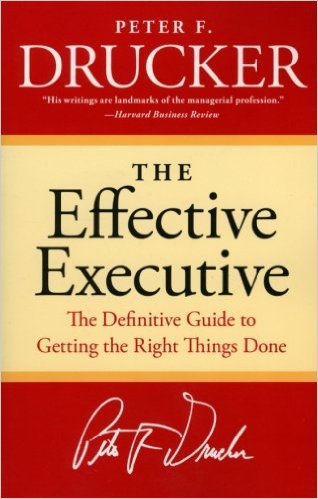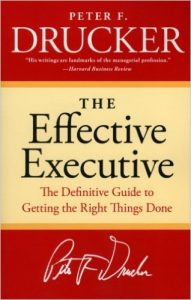Book Review for Goodreads.
Originally published 1967. Edition read was Harper Business, 1993.
I’m too young to have been part of the Drucker Generation. I had always heard him talked of and quoted among the staid and dusty corners of mainstream business, but I never thought to reach back and read him. Drucker’s words and ideas were the Esperanto of an emerging class in the business world of post WWII. He was part and parcel of important board room conversations in the 1950’s and 1960’s.
By the 1980’s when I entered the business world things had changed, or people were tired of basic business sense. We got Peters and Porter and a cadre of super smart guys from Harvard and Stanford who tried to take it to the next level. They all owed their chops to the work of Drucker though. Drucker was their text book. Drucker was the original management consultant the likes of which many owe their profession to today.
I’m not even sure how I came into possession of this book. Perhaps the book sale at the local library where you can buy them for $5 a shopping bag?
I’m not sure how this book pushed its way to the front of the queue ahead of the other 30 books that are waving their little book-arms to get my attention.
But, I’m glad it did because it was a minor revelation to me.
This book must be read not as a small collection of business advice, like a Poor Richards for the executive class, but as a manifesto for the times. A manifesto for an emerging class of business professionals. A manifesto for a society caught in the sea change from basic, patriarchal, industrial capitalism to effective organizations that would be needed to compete and thrive on the world’s stage.
It is Drucker’s plea for American business to get their act together.
The Effective Executive can be seen as anachronistic but also as a history lesson. It is birthed from a point in time in America where the knowledge worker was emerging and a new style of leadership was needed to utilize them. Drucker recognized that this new class of workers needed to be harnessed as the driving force for a new generation of organizations.
He is also interestingly prescient. He talks about how big American car companies needed to change. He talks about Government being made ineffective by competing priories. He scolds that global labor is cheap and the only way to stay competitive in to empower our resources and innovate.
Beyond all the histrionics this little book is also chock full of great tips for anyone who is in business.
I particularly liked the chapters on decision making. Perhaps these chapters might help those currently embroiled in their New Year’s Resolutions?
How do you set your priorities? If you don’t set your priorities, circumstance or ‘pressures’ will set your priorities for you. If you let ‘pressure’ drive your priorities and decisions you’ll always be focusing on the past. This is what Drucker amuses himself by calling them Priorities vs Posterities. Pressure causes us to react and the future-looking priorities are crowded out by the backward-looking posterities.
Decisions that are posterities, when analyzed will likely be someone else’s priority, not yours.
What are some other ways to make bad decisions? Postponing a decision usually makes it less relevant because decisions are rooted in the time of decision. You can also try to make decisions that spread a compromise around to make everyone happy. That guarantees an ineffective solution.
What are the attributes of a good decision?
- Aim high and make it meaningful.
- Make the decision unique to you and your business, don’t put on someone else’s decision.
- Make decisions outward facing.
- Make decisions future focused.
- Make the decision take advantage of an opportunity, not solve a problem.
Good decisions will require courage. Truly great decisions will seem like heresy to the rest of the world. Good decisions are going to make someone mad. That’s ok. As a matter of fact, if you don’t have a dissenting opinion you haven’t looked at the decision well enough. Most effective decisions are disagreeable.
Above all, the thing that makes a decision effective is follow through and execution. The executive must use grit and will power to drive the execution of that decision for it to have effect.
How do you do this? How do you execute a game-changing decision so that it propagates throughout the organization?
In the new (at the time) knowledge worker stacked organization you leverage those knowledge workers to implement the decisions. This is really the key and ties the whole work together. The old capitalist regimes with a handful of executives making decisions and everyone else hopping to were no longer effective and were a dying breed. In order to compete in the post WWII world the knowledge workers throughout the organization needed to be capable of making decisions on their own that aligned with and drove the organization to effectiveness.
That’s what Drucker saw. Organizations that could learn to leverage the knowledge worker would be more effective and more competitive.
This is still the hallmark of effective organizations. The ability to communicate and leverage the individual genius of each worker in a way that is passionately aligned with the goals of the organization. Think about Starbucks or Zappos or any other company that uses culture to enable knowledge workers to do the right thing at the right time for the benefit of the company.
We owe a lot to Peter Drucker. He was a smart observer of the times at a time when modern business was being born. The Effective Executive is a worthy investment of your time, even now in 2016. If not for the timeless business tenants, then for the context it gives us.
Chris Russell – January 2017


